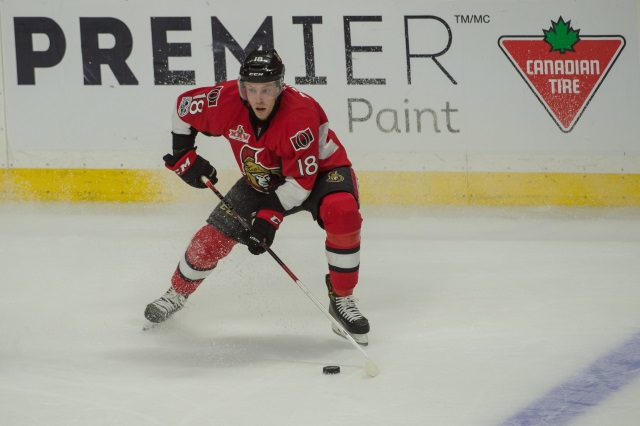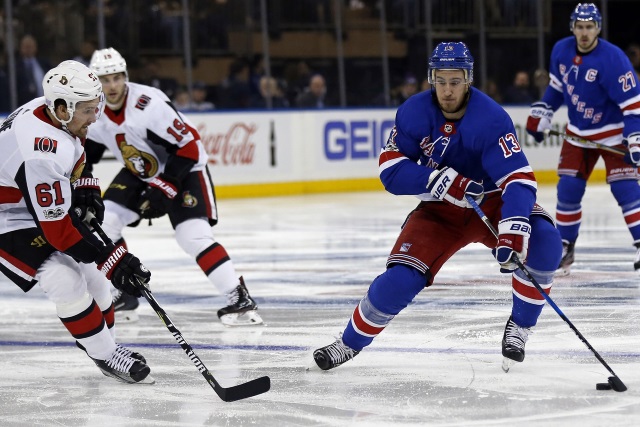The eerie calm of a Saturday night was broken by the finality of a trade again between the Columbus Blue Jackets and Ottawa Senators. This “second leg” of a deal featured Ryan Dzingel and a pick heading to Columbus for picks and Anthony Duclair. Here lie the terms of the deal below:
- Columbus receives Ryan Dzingel and a seventh-round 2019 draft pick
- Ottawa acquires a 2020 second-round pick
- Ottawa acquires a 2021 second-round pick
- The Senators acquire Anthony Duclair
Columbus gets full credit for getting creative in this deal and no first-round pick was given up. It is time to break this down a bit further.
What Ryan Dzingel and the pick means for the Columbus Blue Jackets
Columbus going for it is admirable. Dzingel helps as a 25-30 goal scorer and shows a bit of power-play acumen. Most forget the former Ottawa Senators’ winger scored 23 times last year. He remains on pace for close to 30 this year. Dzingel tallied four power-play goals and might improve on that in Columbus. He ends up on the second unit man-advantage in Columbus but could have Josh Anderson on his other wing. That combination could easily click and may eventually occur.
Dzingel brings the ability to shoot the puck at a good volume while employing better shot selection. His wrist shot is above average but the forward’s ability to get into the slot for shots is much improved. Partially, that is why a pairing with Anderson seems the most prudent. Oliver Bjorkstrand‘s skill set does not quite match up as well, yet. Fortunately, Columbus has enough depth to move Bjorkstrand down a line.
One concern with Dzingel is possession metrics. He was -1% compared to the relative in Ottawa. That says a mouthful. Matt Duchene possessed the ability to drive offense which compensates for a lack of defensive skill. Dzingel still has much to learn there. Perhaps with the Columbus Blue Jackets, the winger can learn more about positional awareness. John Tortorella may bench him a few times for it.
The seventh-round pick is a sweetener as the real deal is Dzingel himself. Essentially, Ryan Dzingel fitting in on the second line increases the balance for Columbus. They can employ a top-six that can put fear into defenses. Their power-play should improve almost by default. Will it be dramatically improved? Time will tell.
What Anthony Duclair and the draft picks mean for the Ottawa Senators
Ottawa continues to stockpiles picks and acquires a player who can score a few goals in Duclair. Unfortunately for Duclair, it just did not work out in Columbus. This becomes his fifth team in five seasons. One has to wonder why. Again, goal scoring is around a 15-20 goal pace at minimal minutes. However, even with increased offensive zone deployment (64.3%), Duclair saw less and less ice time. Duclair makes a lot of defensive mistakes but he also can create matchup problems for the opposition.
For as much as was made into John Tortorella’s savage assertion of Duclair’s game, there lies a shred of truth in there. Now, can Ottawa figure out how to maximize the positives of the winger’s attributes best? One thing is certain. Expect Duclair to see more ice time in Ottawa and maybe on the power-play. Furthermore, this expects to lead to more shots and more scoring chances. Likely, Duclair could get on a hot streak and score 6-8+ goals.
Then the picks enter the forefront. These are not 2019 picks. 2020 figures to be one of the biggest drafts in some time. That is the early assertion. 2021 is a bit early to assess. Hopefully, there is enough depth because Ottawa did not get a Columbus first-round pick. The Ottawa Senators expect to get that from a Mark Stone trade.
Some final observations
Give Jarmo Kekalainen plenty of credit for acquiring Matt Duchene and Ryan Dzingel in two separate trades about 32 hours apart. The other concern with Dzingel is when does the luck run out. He shoots at 16.7% over the past two seasons in Ottawa with an on-ice shooting percentage of 11.5% (5 on 5). Alas, the question is when does that regress and how much? The answer is it may be mitigated because of Columbus and Dzingel will not face the toughest matchups. Finally, Dzingel playing in a pressure situation may result in some unexpected outcomes. No one knows what those will be just yet.





